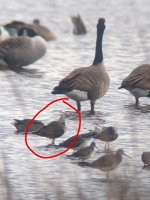Hello,
I'm guessing Godwit of some kind but unsure which. White patch on tail and dark supercilium leads me to Hudsonian but apparently those are rare at this time? Appreciate others' opinions! Also, if anyone has insight into the IDs of the other shorebirds in the photo I would love to know. Yellowlegs?
Best,
Paul
I'm guessing Godwit of some kind but unsure which. White patch on tail and dark supercilium leads me to Hudsonian but apparently those are rare at this time? Appreciate others' opinions! Also, if anyone has insight into the IDs of the other shorebirds in the photo I would love to know. Yellowlegs?
Best,
Paul








